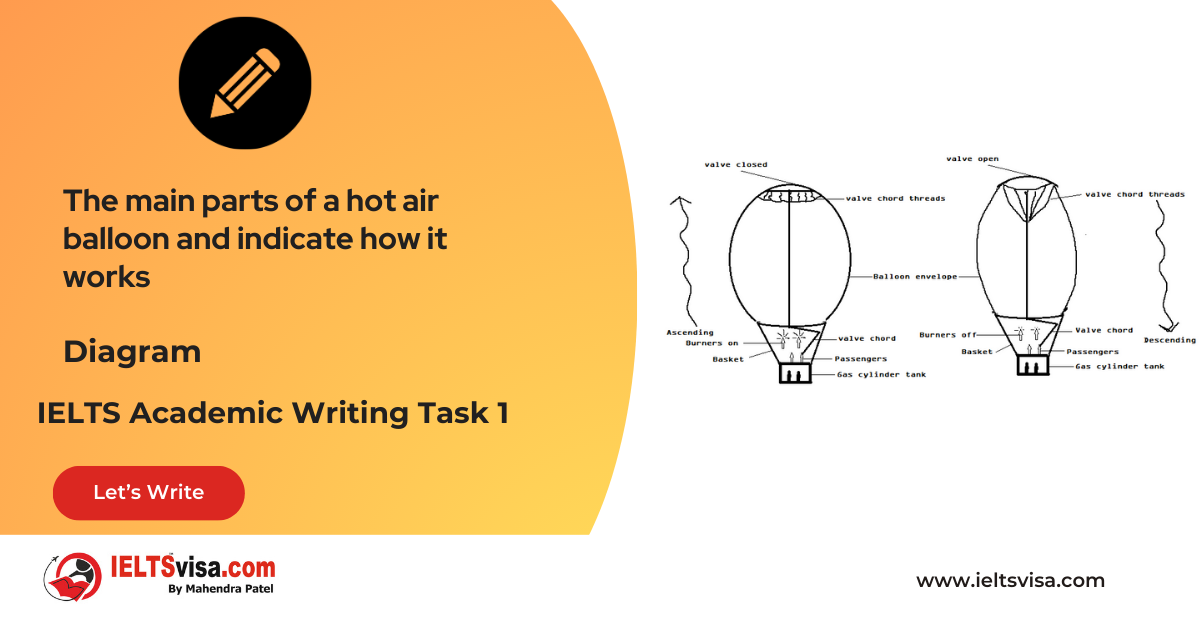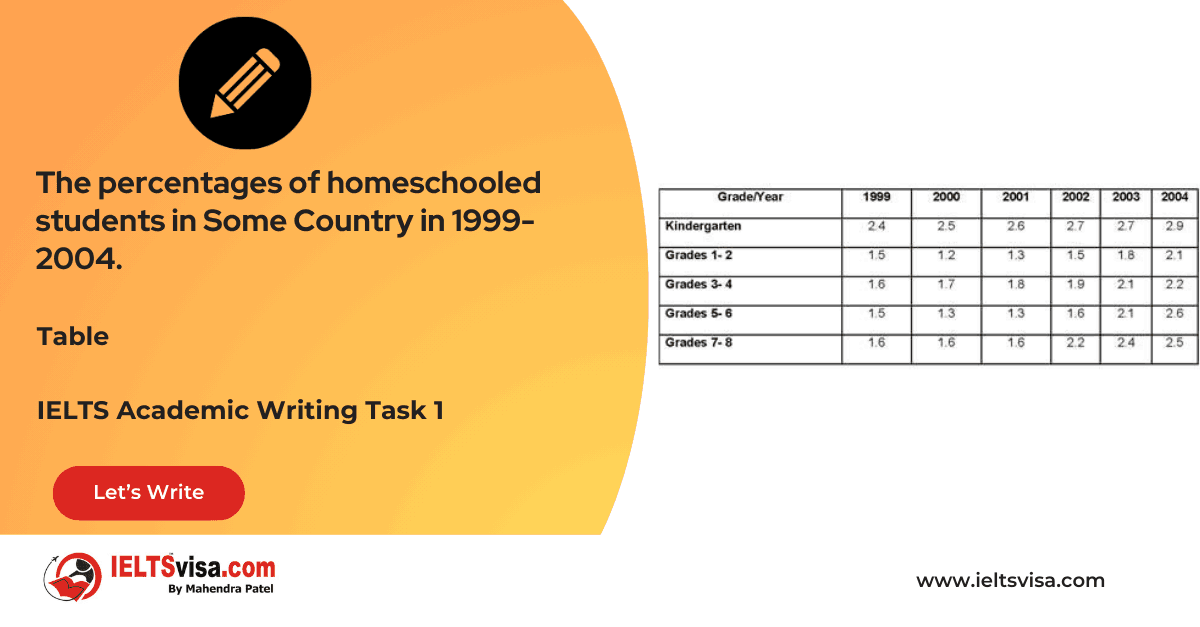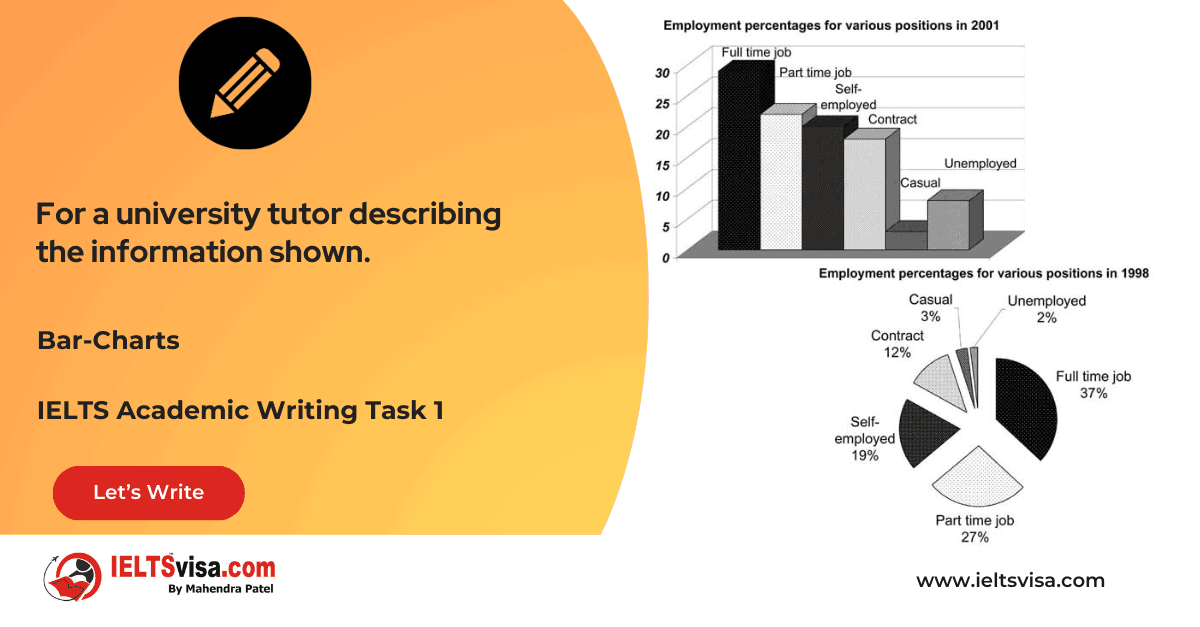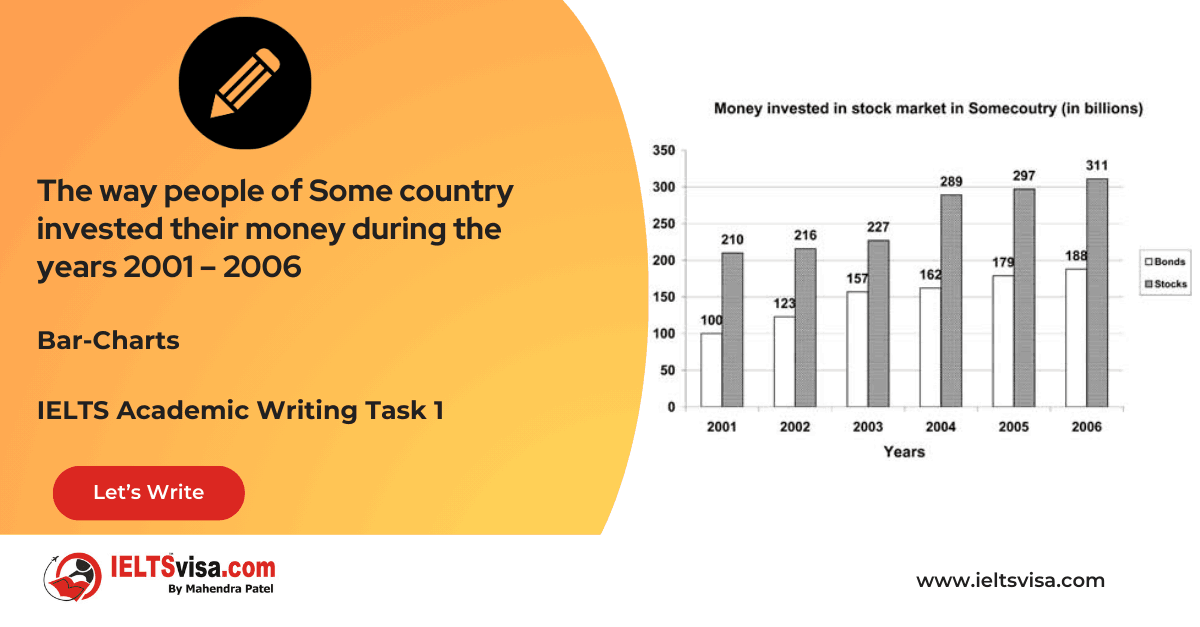Land Used for Organic Crops in Two Countries from 1985 to 2010
IELTS Academic Writing Task 1 - Line Graph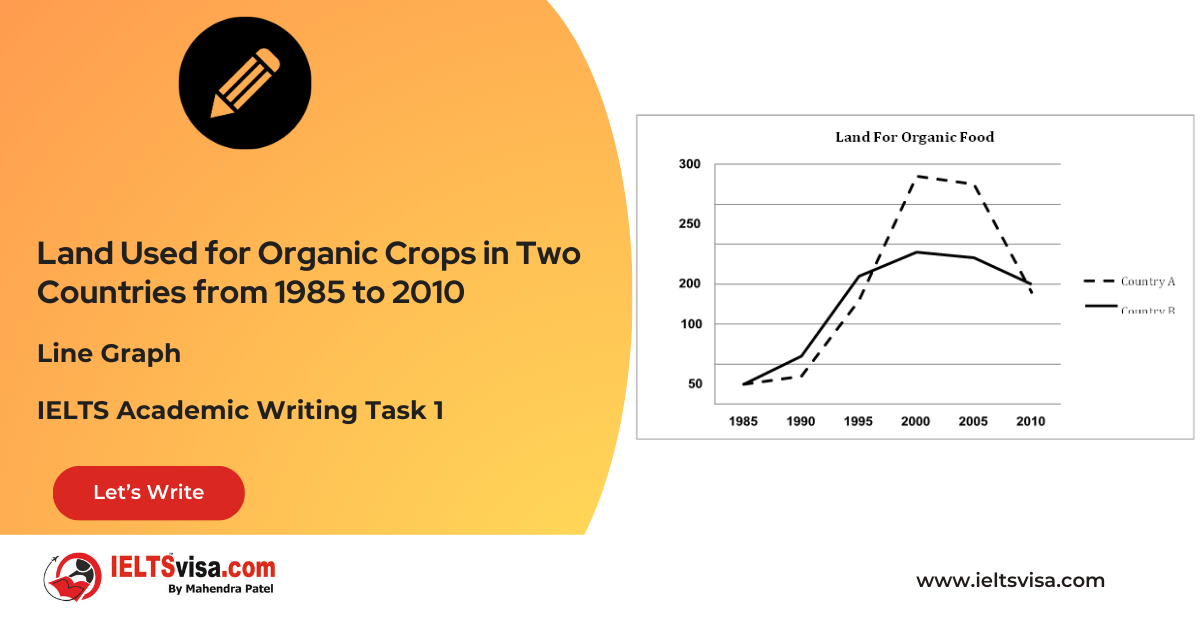
IELTS Writing Task 1 Question
The line graph below shows the land used for organic crops in two countries between 1985 and 2010..
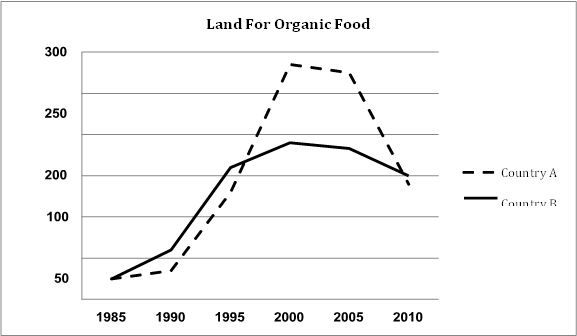
Common questions for the line graph
1. Graph Type: Line Graph
2. Title: Land Used for Organic Crops in Two Countries from 1985 to 2010
3. What are the units of measurement?: Land area (in thousand hectares)
4. Who: Countries A and B
5. When: From 1985 to 2010
6. Where: Countries A and B
7. Topic: Organic farming land usage in two countries
Process Showing and Trends
Comparison 1: Initial Land Use (1985–1990)
- Details:
- Located south of the sea.
- Main road split the town into two halves.
- The industrial area is to the left, and the car park is to the right.
- Predominantly grassland beyond key facilities.
Comparison 2: Changes by 2007
- Details:
1. Both countries saw a sharp rise in land use from 1990 to 1995, surpassing 150,000 hectares.
2. Country A showed the most dramatic growth, reaching a peak of 280,000 hectares by 2000.
3. Country B exhibited a more moderate increase in land use for organic farming.
Comparison 3 : Decline in Land Use (2000–2010)
- Details:
1. After 2000, both countries experienced a gradual decrease in organic farming land.
2. The decline was more noticeable in Country A, dropping to 150,000 hectares by 2010, while Country B also saw a decline to the same level.
Sample Answer
The given line graph illustrates the changes in land used for organic crops in two countries from 1985 to 2010.
In 1985, both countries began with 25,000 hectares allocated to organic farming. Over the next five years, Country A’s land increased modestly to 30,000 hectares, while Country B’s area grew significantly to 60,000 hectares. Between 1990 and 1995, both countries saw a sharp rise, with land usage exceeding 150,000 hectares in each country. Country A’s organic farming area grew rapidly, peaking at 280,000 hectares in 2000. Meanwhile, Country B saw a more moderate increase in land for organic crops.
After 2000, both countries experienced a decline in the amount of land dedicated to organic farming. However, Country A’s decrease was more marked, dropping to 150,000 hectares by 2010, the same level as Country B, which also saw a slight reduction in organic farming land.
Overall, although the land allocated to organic farming grew significantly until 2000, it began to decrease in both countries after that year.
Top 27 Vocabularies
| Vocabulary | Meaning | Synonyms | Examples | Type |
| Escalation | A rapid increase or rise | Surge, increase | “From 1990 to 1995, there was a sharp escalation in the land used for organic crops.” | Noun |
| Moderate | Average or moderate in amount or degree | Average, moderate | “Country B showed a moderate increase in land used for organic farming.” | Adjective |
| Peak | To reach the highest point | Reach, culminate | “Country A reached a peak of 280,000 hectares in 2000.” | Verb/ Noun |
| Decline | A gradual decrease or reduction | Drop, fall | “Both countries experienced a decline in organic farming land after 2000.” | Verb/ Noun |
| Allocated | Assigned or set aside for a specific purpose | Designated, assigned | “In 1985, both countries allocated 25,000 hectares for organic crops.” | Verb |
| Illustrate | To explain or show something clearly | Depict, demonstrate | “The given line graph illustrates the changes in land use.” | Verb |
| Allocate | To distribute resources for a particular purpose | Assign, designate | “Both countries allocated land for organic crops.” | Verb |
| Modestly | To a limited extent or in a humble way | Slightly, moderately | “Country A’s land increased modestly in the first five years.” | Adverb |
| Significantly | In a notable or important way | Substantially, considerably | “Country B’s land grew significantly between 1985 and 1990.” | Adverb |
| Expansion | The process of increasing in size or extent | Growth, enlargement | “There was an expansion in organic farming land after 1990.” | Noun |
| Surge | A sudden large increase | Rise, escalation | “Country B saw a surge in organic farming land between 1990 and 1995.” | Noun |
| Exceed | To be greater than a particular amount | Surpass, outstrip | “Land usage exceeded 150,000 hectares in both countries.” | Verb |
| Rapidly | Happening very quickly | Swiftly, fast | “Country A’s organic farming area grew rapidly.” | Adverb |
| Culmination | The highest or most important point | Peak, climax | “2000 marked the culmination of organic farming expansion.” | Noun |
| Downturn | A decline in activity or success | Decrease, slump | “Both countries experienced a downturn in organic farming after 2000.” | Noun |
| Moderation | The avoidance of excess or extremes | Balance, restraint | “Country B saw a moderate increase in organic farming land.” | Noun |
| Drastically | In a way that has a strong and far-reaching effect | Severely, dramatically | “Country A’s land usage declined drastically after 2000.” | Adverb |
| Fluctuation | Continuous changes in levels or amounts | Variability, instability | “There were fluctuations in the amount of land used for organic farming.” | Noun |
| Stabilize | To become steady or stop changing | Balance, steady | “The decline in organic farming land eventually stabilized.” | Verb |
| Maintain | To keep something in the same state | Preserve, sustain | “Country B maintained a steady level of organic farming land.” | Verb |
| Shrink | To become smaller in size or amount | Reduce, contract | “The land used for organic farming shrank after 2000.” | Verb |
| Recover | To return to a previous good condition | Improve, rebound | “There was no sign of land recovery after 2000.” | Verb |
| Consistently | In a way that does not change over time | Regularly, steadily | “Country B consistently showed a slower increase in land use.” | Adverb |
| Plummet | To fall or drop straight down at high speed | Collapse, plunge | “After peaking in 2000, the land area plummeted sharply.” | Verb |
| Prominent | Standing out or important | Noticeable, significant | “A prominent trend was the rapid increase in organic land from 1990 to 2000.” | Adjective |
| Diminish | To reduce in size, importance, or intensity | Decrease, lessen | “The amount of land used for organic crops gradually diminished.” | Verb |
| Regression | A return to a previous state, often a worse one | Reversal, decline | “The decline in organic farming land can be seen as a regression.” | Noun |

Our Books
Master IELTS Speaking Part 1
IELTS Writing Task 1 Book
IELTS Writing Task 2 Book
Practice IELTS Other Modules
IELTS Listening
The IELTS Listening test assesses how well you can understand spoken English in various contexts. It lasts about 30 minutes and is divided into four sections with a total of 40 questions. The listening tasks become increasingly difficult as the test progresses.
IELTS Academic Reading
The IELTS Academic Reading section assesses your ability to understand and interpret a variety of texts in academic settings. It is designed to evaluate a range of reading skills, including skimming for gist, reading for main ideas, reading for detail, understanding inferences, and recognizing a writer's opinions and arguments.
IELTS Speaking
The IELTS Speaking test assesses your ability to communicate in English on everyday topics. It lasts 11-14 minutes and consists of three parts: introduction, cue card, and a discussion based on the cue card topic.
IELTS General Reading
IELTS General Reading tests your ability to understand and interpret various types of texts. Here are some key areas and types of content you can expect to encounter in the reading section, along with tips for effective preparation.
IELTS Academic Writing Task 1
In IELTS Academic Writing Task 1, you are presented with a visual representation of information, such as graphs, charts, tables, or diagrams, and you are required to summarize, compare, or explain the data in your own words.
IELTS General Writing Task 1
In IELTS General Writing Task 1, you are required to write a letter based on a given situation. The letter can be formal, semi-formal, or informal, depending on the prompt. Here’s a breakdown of the key components to include in your letter
IELTS Academic Writing Task 2
In IELTS Academic Writing Task 2, you are required to write an essay in response to a question or topic. Here’s a guide to help you understand the essential elements of this task
IELTS Exam Tips
To succeed in the IELTS exam, practice regularly, familiarize yourself with the test format, improve your vocabulary, develop time management skills, and take mock tests to build confidence.
Grammer for IELTS
Grammar is the foundation of effective communication in English. Understanding tense usage, subject-verb agreement, and sentence structure enhances clarity and coherence in writing and speaking.
Vocabulary for IELTS
Vocabulary plays a crucial role in the IELTS (International English Language Testing System) exam, especially in the Speaking and Writing sections. Here’s an overview of why vocabulary is important and how it impacts your performance
RECENT IELTS SAMPLES QUESTIONS AND ANSWERS
Task 1 – Diagram – A conference hall built in 1981 and planned for 2020
20:00 Start Pause Stop [df_adh_heading title_infix="IELTS Writing Task 1 Question" use_divider="on"...
Task 1 – Table – The percentages of homeschooled students in Some Country in 1999-2004.
20:00 Start Pause Stop [df_adh_heading title_infix="IELTS Writing Task 1 Question" use_divider="on"...
Task 1 – Table – For a university tutor describing the information shown.
20:00 Start Pause Stop [df_adh_heading title_infix="IELTS Writing Task 1 Question" use_divider="on"...
Task 1 – Bar-Charts – The way people of Some country invested their money during the years 2001 – 2006
20:00 Start Pause Stop [df_adh_heading title_infix="IELTS Writing Task 1 Question" use_divider="on"...
Task 1 – Diagram – Rainwater Harvesting and Conversion to Drinking Water in an Australian Town.
20:00 Start Pause Stop [df_adh_heading title_infix="IELTS Writing Task 1 Question" use_divider="on"...
Task 1 – Column graph – Percentage of Young People Enrolled in Universities in 2000 and 2007.
20:00 Start Pause Stop [df_adh_heading title_infix="IELTS Writing Task 1 Question" use_divider="on"...

